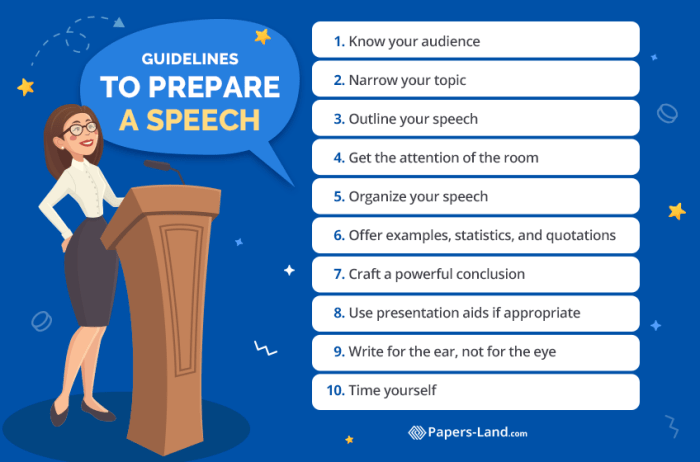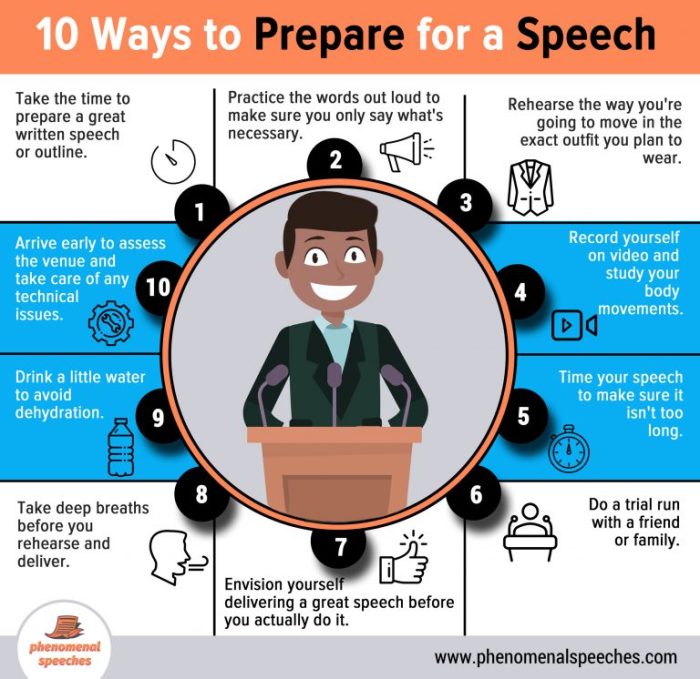Most speech instructors prepare students for speeches by: – Most speech instructors prepare students for speeches by equipping them with the essential knowledge and skills to craft, deliver, and refine their presentations effectively. This comprehensive guide delves into the multifaceted approaches employed by speech instructors to empower students in the art of public speaking.
In this guide, we will explore the fundamental elements of speech preparation, including structure, content development, language crafting, delivery techniques, practice strategies, and special considerations for diverse learning styles and speech contexts. By understanding these core principles, students can gain confidence and proficiency in their public speaking abilities.
Teaching Speech Structure
Effective speech instructors prepare students for speeches by teaching them the typical structure of a speech, including the introduction, body, and conclusion. They provide examples of effective speech structures and emphasize the importance of organizing speech content logically and coherently.
Explain the typical structure of a speech, including introduction, body, and conclusion.
The introduction should capture the audience’s attention, establish the topic, and provide a clear thesis statement. The body should develop the main points of the speech, providing evidence and examples to support each point. The conclusion should summarize the main points, restate the thesis, and provide a memorable closing statement.
Provide examples of effective speech structures.
Instructors may provide examples of well-structured speeches from famous orators or from student speeches that have been particularly effective. They may also provide Artikels or templates that students can use to structure their own speeches.
Discuss the importance of organizing speech content logically and coherently.
Instructors emphasize the importance of organizing speech content in a way that makes it easy for the audience to follow. They explain that logical organization helps the audience understand the speaker’s main points and retain the information presented.
Developing Content: Most Speech Instructors Prepare Students For Speeches By:

Instructors guide students in researching and gathering relevant information for their speeches. They help students develop clear and concise main points and teach strategies for supporting main points with evidence and examples.
Guide students in researching and gathering relevant information for their speeches.
Instructors may provide students with resources for finding credible information, such as databases, libraries, and reputable websites. They may also teach students how to evaluate the credibility of sources and how to avoid plagiarism.
Help students develop clear and concise main points.
Instructors help students identify the main points of their speeches and develop clear and concise thesis statements. They may provide students with exercises to practice writing thesis statements and may offer feedback on students’ drafts.
Teach strategies for supporting main points with evidence and examples.
Instructors teach students how to use evidence and examples to support their main points. They may provide students with examples of effective evidence and examples and may offer feedback on students’ use of evidence in their speeches.
Crafting Language

Instructors explain the use of persuasive language and rhetorical devices. They provide techniques for improving word choice and sentence structure and discuss the importance of clarity, conciseness, and impact in speechwriting.
Explain the use of persuasive language and rhetorical devices.
Instructors explain how persuasive language and rhetorical devices can be used to engage the audience and make the speech more effective. They may provide examples of persuasive language and rhetorical devices and may offer feedback on students’ use of these techniques in their speeches.
Provide techniques for improving word choice and sentence structure.
Instructors teach students how to choose words that are clear, concise, and impactful. They may provide students with exercises to practice word choice and may offer feedback on students’ use of language in their speeches.
Discuss the importance of clarity, conciseness, and impact in speechwriting., Most speech instructors prepare students for speeches by:
Instructors emphasize the importance of clarity, conciseness, and impact in speechwriting. They explain that clear speeches are easy for the audience to understand, concise speeches are focused and to the point, and impactful speeches leave a lasting impression on the audience.
Delivery Techniques
Instructors teach students effective vocal techniques, including volume, pitch, and pacing. They provide guidance on body language, gestures, and eye contact and help students overcome stage fright and develop confidence in their delivery.
Teach students effective vocal techniques, including volume, pitch, and pacing.
Instructors teach students how to use their voices effectively to engage the audience. They may provide students with exercises to practice vocal techniques and may offer feedback on students’ vocal delivery in their speeches.
Provide guidance on body language, gestures, and eye contact.
Instructors teach students how to use body language, gestures, and eye contact to enhance their speeches. They may provide students with examples of effective body language and gestures and may offer feedback on students’ use of these techniques in their speeches.
Help students overcome stage fright and develop confidence in their delivery.
Instructors help students overcome stage fright and develop confidence in their delivery. They may provide students with strategies for managing stage fright and may offer opportunities for students to practice their speeches in a supportive environment.
Practice and Feedback
Instructors create opportunities for students to practice their speeches in a supportive environment. They provide constructive feedback to help students identify areas for improvement and encourage students to self-assess and reflect on their progress.
Create opportunities for students to practice their speeches in a supportive environment.
Instructors may provide students with opportunities to practice their speeches in class, in small groups, or in front of a video camera. They may also offer opportunities for students to receive feedback from peers and from the instructor.
Provide constructive feedback to help students identify areas for improvement.
Instructors provide students with constructive feedback on their speeches. They may offer feedback on students’ content, delivery, and overall effectiveness. They may also provide students with suggestions for improvement.
Encourage students to self-assess and reflect on their progress.
Instructors encourage students to self-assess their speeches and to reflect on their progress. They may provide students with self-assessment tools or may ask students to write reflective essays about their speeches.
Special Considerations

Instructors discuss strategies for accommodating students with diverse learning styles and needs. They provide guidance on adapting speech preparation techniques for different speech contexts and audiences and address the ethical considerations and responsibilities of public speaking.
Discuss strategies for accommodating students with diverse learning styles and needs.
Instructors may provide students with different learning materials and activities to accommodate their diverse learning styles. They may also offer different assessment options to accommodate students with different needs.
Provide guidance on adapting speech preparation techniques for different speech contexts and audiences.
Instructors may provide students with guidance on how to adapt their speech preparation techniques for different speech contexts and audiences. They may discuss the importance of considering the audience’s knowledge, interests, and values when preparing a speech.
Address the ethical considerations and responsibilities of public speaking.
Instructors may discuss the ethical considerations and responsibilities of public speaking. They may discuss the importance of being honest, accurate, and respectful when speaking in public.
Query Resolution
What are the key elements of speech structure?
Speech structure typically consists of an introduction, body, and conclusion. The introduction grabs attention, states the thesis, and provides an overview. The body presents the main points, supported by evidence and examples. The conclusion summarizes the key points, restates the thesis, and leaves a lasting impression.
How can students develop clear and concise main points?
Instructors guide students to identify the central ideas of their speeches and craft main points that are specific, focused, and supported by relevant evidence. They encourage students to use clear language, avoid jargon, and organize their points logically.
What techniques can instructors use to improve students’ speech delivery?
Instructors teach effective vocal techniques, including volume, pitch, and pacing. They provide guidance on body language, gestures, and eye contact. Additionally, they help students overcome stage fright and build confidence in their delivery through practice and constructive feedback.